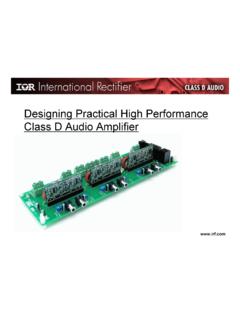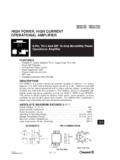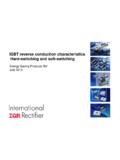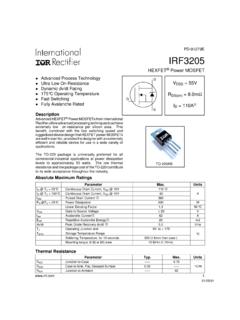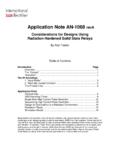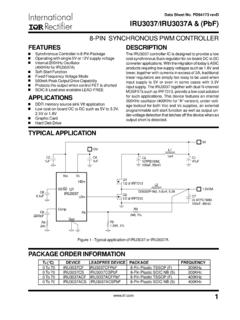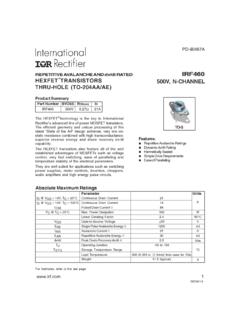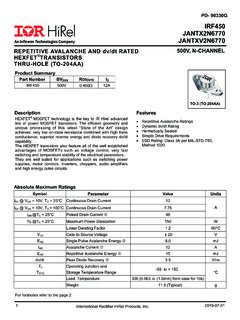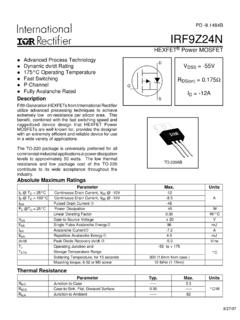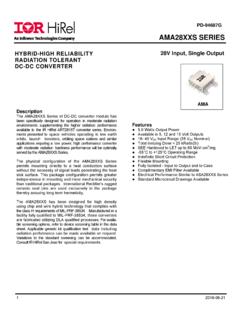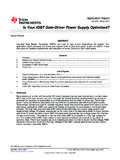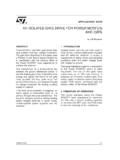Transcription of DC to AC Inverter IGBT Demo Board - Infineon …
1 WTC June 27, 2008 EEnneerrggyy SSaavviinngg PPrroodduuccttss DC to AC Inverter igbt Demo Board Devices: IRGB4062 DPBF (600V/24A Trench igbt ) high Side IGBTs IRG4BC20SD-PBF (600V/10A S-type Planar igbt ) Low Side IGBTs IRS2106S (600V half bridge driver IC) The purpose of a DC to AC Inverter is to convert DC voltage to a pure sinusoidal output voltage in applications such as UPS, solar Inverter and frequency converter. This demo Board is designed to operate without fan up to 500W. Figure 1. Connection diagram. Equipment required: 200V, 3A DC power supply 20V, 100 mA DC power supply 120V/500W load bank such as resistors, light bulbs or a portable heater Connection should be made according to the diagram shown on Figure 1.
2 Theory of operation: A full bridge topology is used to implement the DC to AC Inverter . During positive output half cycle, Q1 is sine pulse width modulated (sine PWM) while Q4 is kept on. During negative output half cycle, Q2 is sine pulse width modulated while Q3 is kept on. The switching frequency of the high side and low side IGBTs are 20 kHz and 60 Hz, respectively. This switching technique produces 60 Hz AC sine wave across the output capacitor C4 after inductor L1. 200V DC Supply 20V DC Supply 120V/500W Load WTC June 27, 2008 EEnneerrggyy SSaavviinngg PPrroodduuccttss Q1 and Q2 are chosen to be ultrafast trench IGBTs, IRGB4062 DPBF which offers balanced conduction and switching losses at 20 kHz.
3 Q3 and Q4 are standard type (S-type) planar igbt since these IGBTs only switch at 60 Hz. Low conduction loss igbt is essential for Q3 and Q4 since conduction loss is the dominant factor while switching loss is not at 60 Hz. Each leg of the H-Bridge is driven using a high voltage gate driver IC, IRS2106 SPBF, with bootstrap power supply technique for the high side. Using IRS2106 SPBF eliminates the requirement for an isolated power supply for the high side drive. This translates into increase efficiency and parts count reduction of the overall system. Some benefits of the H bridge topology and switching technique on this demo Board are : 1.
4 high efficiency since Q1 and Q2 copack diodes are not subjected to the freewheeling current and Q3 and Q4 have majority of conduction loss and very little switching loss. 2. No cross conduction possibility since switching is done on diagonal device pair only at any time (Q1 and Q4 or Q2 and Q3). 3. Operate from single DC bus supply eliminating the need for a negative DC bus. 4. IGBTs are driven using high voltage gate driver IC with bootstrap technique. There is no separate floating power supply required for the high side drive. Bootstrap capacitors for these drivers get refreshed every switching cycle (50 usec) when current freewheels on the low side IGBTs copackage diodes.
5 Q4 IRG4BC20SD-PBFQ3 IRG4BC20SD-PBFQ2 IRGB4062 DPBFQ1 IRGB4062 DPBFVCC1 HIN2 LIN3 COM4LO5VS6HO7VB8U3IR2106 VCC1 HIN2 LIN3 COM4LO5VS6HO7VB8U4IR2106L1 INDUCTOR1C1100 ,1WR775K, +7RB0/AN4/INT08RB5/PGM/KBI111RB6/PGC/T1 OSO/T1 CKI/P1C/KBI212RB7/PGD/T1 OSI/P1D/KBI313 VDD/AVDD14 OSC2/CLKO/RA615 OSC1/CLKI/RA716RB2/P1B/INT217RB3/CCP1/P1 A18RB1/AN5/TX/CK/INT19RB4/AN6/RX/DT/KBI0 10U5 PIC18F1320- +C547uf/25v+C647uf/25v+C910uf/16vIN1 GND2 OUT3U1 NJM78M15 FAVin1 GND2 Vout3U2 Comment: Figure 2. Schematic of the demo Board WTC June 27, 2008 EEnneerrggyy SSaavviinngg PPrroodduuccttss Figure 3. Output waveforms of gate driver ICs and sinusoidal output voltage.
6 Operation: Always start the system by applying power to the +20V power supply prior to applying +200V DC bus. With a 120V/500W resistive load connected, the output will be a nominal 120V/60 Hz AC sinusoidal voltage as shown in Figure 3. This figure also shows the output gate voltages across each igbt showing 60 Hz commutation and 20 kHz sine PWM signals for low and high side devices, respectively. WARNING The output voltage is taken from the legs of the full bridge Inverter after the L-C filter. In order to obtain the same sinusoidal output voltage waveform shown in Figure 3, an appropriate high voltage differential voltage probe is necessary.
7 If such probe is not available, measure each output using a ground referenced oscilloscope probe and subtract the resulting waveforms on the oscilloscope. Please consult with individual oscilloscope manual on how to do this measurement. Power Loss Comparisons: Using the technique described in this demo Board achieves the lowest power dissipation on a typical full bridge solar Inverter application. Figure 4 summarizes differences in power dissipation based on different switching technique and igbt combinations. WTC June 27, 2008 EEnneerrggyy SSaavviinngg PPrroodduuccttss Reduction in Power Dissipation Using Combination of Trench and Standard Speed Planar IGBTs5 W10 W15 W20 W25 W30 W35 W40 W4 A6 A8 A10 A12 A14 AOutput RMS current (Amps)Total Power Dissipation (Watts)Planar IGBTs - (All 20 kHz)Planar IGBTs (HS: 20kHz + LS: 50Hz)Trench and S-type IGBTs (HS: 20kHz + LS: 60Hz) Figure 4.
8 Power Dissipation Comparisons of Different Switching Technique and igbt Combinations.
